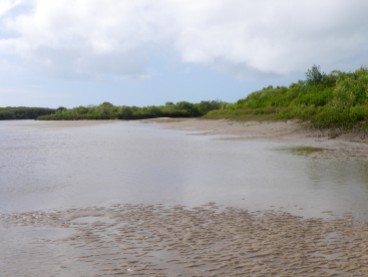Saturday
On Saturday, I was back in Byfield National Park, so I decided to try fishing further up Water Park Creek, near Kelly’s Landing. There are thick mangroves lining the creek with only a few openings on to the muddy banks, along this stretch. A few visitors had arrived to camp beside the river and although we are well into the ‘dry’ season, the day started with rain patches, grey skies and drizzle.
This is another muddy spot and I was soon ankle-deep in the stuff. I squelched up river, using the same technique as I had on Wednesday. I was fishing with 8lb fluorocarbon leader, my light spin rig, small soft plastic minnows and shrimps on a 1/8th ounce, # 1 hook jighead. It was a new moon so there was a big, powerful outgoing tide.
The water was fairly shallow but formed some deeper channels close to the bank. In a few places there were oyster covered rocky outcrops and I settled in the mud, a few metres short of one of these and concentrated my efforts casting close to it.
I was using the GULP 3” Minnow in the Pearl Watermelon Colour. This was as close as I could get to the small bait fish. They were cruising up and down beside the rocks in small schools. After a few minutes, there was a surge and splash as something hit them from below.
I dropped my lure as close as I could to the rocks and let it sink. After about 10 seconds, I hopped it up, off the bottom and felt some resistance. I had a small flathead, about 35cm long. I persisted, casting along the edge of the mangrove roots and I soon had another – a bit over 40cm. I had found a patch and I caught three more over the next 30 minutes, all about the same size, in the same general area.
I kept fishing this spot for more than hour. As the tide went out I was able to climb onto the rocks and cast further upstream, from them. I was soaked, muddy, cold and kept losing gear to the oyster covered rocks and mangrove roots. I was pondering the long squelch back to the car when a freight train smashed the soft plastic, very close to the base of the rocks.
The fish took off, but fortunately it swam out into mid-stream. I only had 8lb leader on so I left the drag alone but did everything I could to keep the fish way from the rocks. It darted back into the mangrove roots and I thought it was gone. I kept the pressure on, but did not try to pull it out – I would just have snapped the light leader. After what seemed like a few minutes but was most likely 30 seconds, I saw the leader wiggle and the fish swam out. I pulled it a little further out and then tightened the drag and quickly lifted it clear of the water. It was a handsome mangrove jack – no monster – about 30 cm long. I took a few pictures and released it.
I decided to finish the session on a high note and so I gradually squelched and slid my way back to the car. On the way, I caught a couple more small flathead. Despite several interludes with the Zman Minnowz, I had not been successful with them – it was a GULP day today. Perhaps a different profile Zman would have worked as well as the GULP Minnow, but I think in the muddy water, the GULP scent may have been an advantage.





































